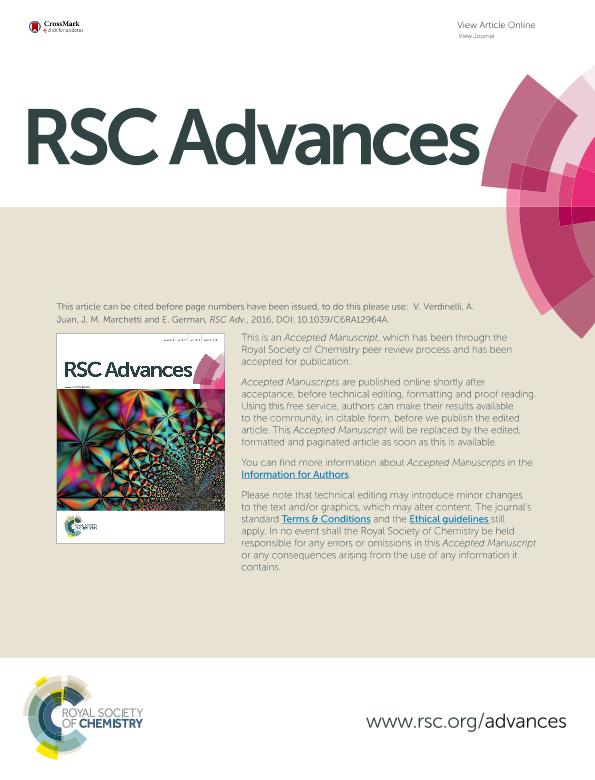Mostrar el registro sencillo del ítem
dc.contributor.author
Verdinelli, Valeria

dc.contributor.author
Juan, Alfredo

dc.contributor.author
Marchetti, Jorge Mario

dc.contributor.author
German, Estefania

dc.date.available
2018-10-12T14:00:44Z
dc.date.issued
2016-06
dc.identifier.citation
Verdinelli, Valeria; Juan, Alfredo; Marchetti, Jorge Mario; German, Estefania; A microscopic level insight into Pt doped TiZn (001) surface for hydrogen energy storage usage; Royal Society of Chemistry; RSC Advances; 6; 77; 6-2016; 73566-73575
dc.identifier.issn
2046-2069
dc.identifier.uri
http://hdl.handle.net/11336/62287
dc.description.abstract
The interaction of hydrogen and platinum with B2-TiZn (001) surface was studied by means of spin-polarized density functional theory (DFT) calculations. H and Pt on TiZn adsorption energies were calculated taking into account high symmetry adsorption sites. Both the adatoms prefer to be adsorbed on the hollow site where the higher coordination number allows them to minimize the repulsion among the overlapping charge densities of them and the surface. Furthermore, the influence of pre-adsorbed Pt on the H adsorption was analyzed in detail. It was found that this process is enhanced in Pt doped TiZn surface. The electronic structures and changes in the chemical bonding for both the adsorbates on the Ti alloy surface were computed by density of states (DOS) and overlap population (OP) methods, concluding that 3dx2-y2, 3dz2 and 3pz Ti, 5pz Pt orbitals play an important role in H adsorption, as well as it was deduced that the strong overlap between Pt and Ti orbitals allows H atoms to bond more effectively on the surface. Bader's analysis revealed that H and Pt act as electron acceptors, whereas surface Ti-atoms act as electron donors during the H adsorption process.
dc.format
application/pdf
dc.language.iso
eng
dc.publisher
Royal Society of Chemistry
dc.rights
info:eu-repo/semantics/openAccess
dc.rights.uri
https://creativecommons.org/licenses/by-nc/2.5/ar/
dc.subject
Dft
dc.subject
Hydrogen
dc.subject.classification
Astronomía

dc.subject.classification
Ciencias Físicas

dc.subject.classification
CIENCIAS NATURALES Y EXACTAS

dc.title
A microscopic level insight into Pt doped TiZn (001) surface for hydrogen energy storage usage
dc.type
info:eu-repo/semantics/article
dc.type
info:ar-repo/semantics/artículo
dc.type
info:eu-repo/semantics/publishedVersion
dc.date.updated
2018-10-08T17:58:27Z
dc.journal.volume
6
dc.journal.number
77
dc.journal.pagination
73566-73575
dc.journal.pais
Reino Unido

dc.journal.ciudad
Cambridge
dc.description.fil
Fil: Verdinelli, Valeria. Consejo Nacional de Investigaciones Científicas y Técnicas. Centro Científico Tecnológico Conicet - Bahía Blanca. Instituto de Física del Sur. Universidad Nacional del Sur. Departamento de Física. Instituto de Física del Sur; Argentina
dc.description.fil
Fil: Juan, Alfredo. Consejo Nacional de Investigaciones Científicas y Técnicas. Centro Científico Tecnológico Conicet - Bahía Blanca. Instituto de Física del Sur. Universidad Nacional del Sur. Departamento de Física. Instituto de Física del Sur; Argentina
dc.description.fil
Fil: Marchetti, Jorge Mario. Consejo Nacional de Investigaciones Científicas y Técnicas; Argentina. Norwegian University of Life Sciences; Noruega
dc.description.fil
Fil: German, Estefania. Consejo Nacional de Investigaciones Científicas y Técnicas. Centro Científico Tecnológico Conicet - Bahía Blanca. Instituto de Física del Sur. Universidad Nacional del Sur. Departamento de Física. Instituto de Física del Sur; Argentina
dc.journal.title
RSC Advances
dc.relation.alternativeid
info:eu-repo/semantics/altIdentifier/doi/https://dx.doi.org/10.1039/C6RA12964A
dc.relation.alternativeid
info:eu-repo/semantics/altIdentifier/url/https://pubs.rsc.org/en/Content/ArticleLanding/2016/RA/C6RA12964A
Archivos asociados
